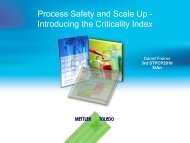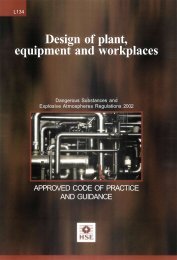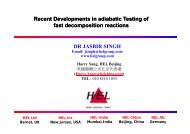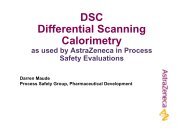Designing and operating safe chemical reaction processes HSG143
Designing and operating safe chemical reaction processes HSG143
Designing and operating safe chemical reaction processes HSG143
You also want an ePaper? Increase the reach of your titles
YUMPU automatically turns print PDFs into web optimized ePapers that Google loves.
Health <strong>and</strong> SafetyExecutive100 The results of the screening tests will give you a preliminary indication of:(a) the possibility of thermal decomposition;(b) the quantity <strong>and</strong> rate of heat release;(c) gas evolution;(d) induction time effects (autocatalysis) - ie the development of thermal instabilityafter prolonged storage; <strong>and</strong>(e) high-rate decompositions (showing that a substance could deflagrate).101 Often the initial deviation in the temperature trace is quoted as the initialexotherm temperature or the onset temperature (see Glossary). You must take carein interpreting these temperatures. A number of factors affect the temperature thatare unrelated to the inherent <strong>chemical</strong> stability of the test material. These include:(a) the sensitivity of the test device;(b) the sample size;(c) the experimental heating mode <strong>and</strong> heating rate (eg the onset temperatureincreases as the rate of heating of the sample increases);(d) heat losses from the sample container;(e) <strong>reaction</strong>s with the sample container; <strong>and</strong>(f) sample vaporisation prior to decomposition.An explosion occurred in a process vessel involving a thermally unstablematerial. Published values of the onset temperature for thermal decomposition inlaboratory tests were in the range 270-300 o C. However, following the incident,further investigation indicated that the material would decompose at around150 o C on the plant scale.102 What you have achieved at this point in the assessment process is a goodintroductory underst<strong>and</strong>ing of your chosen <strong>chemical</strong> process <strong>and</strong> the hazardsinvolved. You may now have sufficient information to define the <strong>safe</strong> <strong>operating</strong>envelope for full-scale plant, particularly if you are going to operate at temperatureswell below the onset temperature for runaway or decomposition when related tothe <strong>operating</strong> conditions.103 However, in a number of cases, you will need to carry out more detailed teststo determine the <strong>safe</strong> <strong>operating</strong> envelope.Reaction calorimetry104 It is possible for you to directly measure the instantaneous heat output of areacting system due to <strong>chemical</strong> or physical <strong>processes</strong> as a function of the processtime. This quantity shows directly whether <strong>and</strong> how quickly <strong>chemical</strong> conversionsoccur in the process phase under consideration. Such an approach can be useful,not only from a <strong>safe</strong>ty perspective but also for process design <strong>and</strong> optimisation.<strong>Designing</strong> <strong>and</strong> <strong>operating</strong> <strong>safe</strong> <strong>chemical</strong> <strong>reaction</strong> <strong>processes</strong> Page 22 of 64










